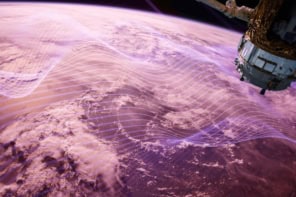
Atmospheric gravity waves drive winds, temperature and chemical composition in the middle and upper atmosphere, but not enough is known about those that occur at higher altitudes. Now though, an international team of researchers has unexpectedly discovered that the new “Day/Night Band” (DNB) sensor, on-board a US environmental satellite, can detect disturbances in the upper atmosphere’s nightglow caused by the waves.
“The DNB observations reveal a complex array of gravity waves in the upper atmosphere that have never before been observed globally at this spatial detail, says Steve Miller of Colorado State University, US, adding that all of the data are available thanks to the sensor’s extreme sensitivity to visible and near-infrared light.
Dark clouds
The DNB is part of the Visible Infrared Imaging Radiometer Suite (VIIRS) on the US NOAA/NASA Suomi National Polar-orbiting Partnership environmental satellite launched in October 2011. The sensor, which detects wavelengths of 505–890 nm, sits 834 km above the Earth and images the atmospheric state as it races by at about 7 km/s. When assessing their sensor’s performance, Miller and colleagues noticed clouds in images taken on nights without moonlight. They realized that the instrument could detect nightglow emissions, which in this case were reflecting off the clouds. Nightglow, also known as airglow, is due to emissions of light in the upper atmosphere from atomic oxygen, sodium and hydroxyl radicals. The emissions are strongest at about 85–95 km, around the mesopause.
Although the DNB sensor is optimized to image the nocturnal surface and lower atmosphere at extremely low levels of light, the team discovered it can pick up nightglow emissions on dark nights. These emissions are sometimes disrupted by gravity waves – disturbances to the density of the atmosphere that gravity and buoyancy act to restore – that are the main form of energy exchange between the lower and upper atmosphere.
Volcanic waves
The gravity waves alter the local temperature and density, modulating the intensity of nightglow emissions and creating rippling patterns of visible light. They may appear as alternating bright and dark bands or as complex patterns, and the team found that the DNB can image the waves with a horizontal resolution of around 0.74 km.
The team imaged gravity waves resulting from a number of phenomena, including mountains, hurricanes, thunderstorms, tropical cyclones, the jet streams of intensifying cold fronts, mesospheric bores and, in the first known spaceborne measurement of its kind, a volcano. Chile’s Calbuco volcano erupted in April 2015, sending a plume of ash into the stratosphere and making a concentric-ring gravity-wave pattern in the nightglow above.
Miller says that the volcanic eruption suggests that other seismic-related airglow signals are yet to be observed, such as “a large earthquake, which may produce an observable ‘bright-sky’ airglow response and/or gravity-wave train coupled to a tsunami front”.
Miller cautions that as their sensor was not optimized for these kinds of observations, there are a number of caveats to working with the data, but there are many more discoveries to come. “There are many wave structures that we have difficulty attributing or explaining. We anticipate that we have not observed all of the possible forms of gravity waves,” he adds.
Better predictions
Because they drive circulation patterns at high altitudes, atmospheric gravity waves also tie back to the weather and climate that we experience near the surface, so this new data could help to improve predictions of climate and climate change. Miller explains that data for the lower atmosphere – taken from surface-based sensors and satellites – are relatively good, but the information for the upper atmosphere is comparatively sparse. The DNB observations could help researchers to understand the structural details of gravity waves produced globally by a variety of mechanisms.
“As a satellite-based sensor, the DNB provides global coverage, and hence an ability to capture wave activity over remote regions and above clouds that would obscure surface-based viewing,” says Miller, explaining that these DNB measurements are unique when compared with most other existing satellite observations. The Ionosphere, Mesosphere, upper Atmosphere, and Plasmasphere (IMAP) Visible-light and Infrared spectrum Imager (VISI), on board the International Space Station, is the only other kit that can provide horizontal details of upper-atmosphere gravity waves, but its resolution is 10 km, an order of magnitude coarser than the DNB’s.
Because the DNB is slated to fly on the NOAA’s Joint Polar Satellite System (JPSS) satellites well into the next decade, it could prove useful to researchers analysing decadal-scale trends in wave activity as they attempt to improve model parameterizations. And by combining DNB observations with measurements of gravity waves in the middle atmosphere from the Advanced Infrared Sounder on NASA’s Aqua satellite or the Cross-track Infrared Sounder (CrIS) on the same JPSS satellites, researchers could study the 3D structure of the waves.
Miller and colleagues would like to develop quantitative ways to extract as much information as possible from the “challenging” DNB imagery. They also hope to collaborate with the IMAP/VISI research team and groups operating surface-based nightglow sensors, to compare information content at different spatial resolutions.
The work is reported in PNAS.
- A version of this article first appeared on environmentalresearchweb



